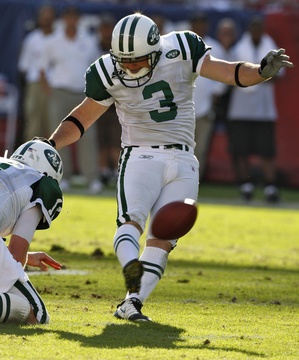Jay Feely hopes NFL's attempts to reduce concussions influences prep level; local coaches agree
Former Michigan placekicker Jay Feely doesn’t have to worry about the long-term health ramifications of tackling or being tackled on a daily basis.
But when Feely signed up to be an NFL Players representative for the Arizona Cardinals, it was because he wanted to have an impact on the game of football beyond what transpires on Sunday afternoons.
When he voted yes on a new collective bargaining agreement that attempts to reduce the risk of concussions in the NFL, Feely felt he accomplished exactly that.

Jay Feely
AP photo
“I think that when you limit those contact hits, you take away the opportunity to get concussions,” Feely said shortly after casting his last Monday. “I think it will help a lot, I really do.”
Last year, Feely spoke before the Arizona state senate in support of a bill aimed at reducing concussions in youth sports and hopes the latest action in the NFL persuades high school coaches to reduce full-contact practices.
Chelsea High School football coach Brad Bush said no change is needed for his team due to the evolution of his methods in his 15 years as head coach.
With just over two weeks separating his team’s first day of padded practice and its first game, Bush said two-a-days will still be part of his plan, but what those entail might surprise people.
“We probably spend almost as much time in the classroom as we do on the field,” Bush said. “Technology has helped us become better coaches -- through film and other methods -- the same way it’s helped us become better teachers in the classroom.”
Bush said only one session of his team's two-a-days involve full contact and that his team is never on the field for more than two hours.
“There’s a point of diminishing return,” Bush said. “It’s not the grueling two-a-day practice that people envision.”
During the season, hitting on Tuesdays and Wednesdays is standard fare for most teams, as opposed to the once-a-week limitations as part of the new NFL deal.
But even in a place like Milan -- which has long prided itself on being a physical program -- the padded, live practices are tempered to a degree.
First-year Milan coach Jesse Hoskins estimated that 12-24 minutes per padded practice during the season are spent on live hitting and maybe twice as long during just one of the sessions of preseason two-a-days.
Hoskins said he learned how to balance being a hard-working, hard-hitting team with safety while he was a player and assistant under longtime Milan coach Steve Robb.
“When we hit, we hit hard, but (Robb) never tried to beat us up,” Hoskins said. “Our kids work hard all year on strength and conditioning and our priority is keeping them healthy during the season.”
A former NFL player, first-year Skyline coach Rod Jones said he was fortunate during his pro playing days to have coaches that subscribed to the new model for NFL practices. The same wasn’t true when he played in college at Kansas.
“We had a tough cat in college, in the early '90s. All day camp and we’d go hard all day. There was no such thing as a walk through," said Jones. “In the long run, that does more bad than good. ... You’re physically exhausted and you can’t have that a high level of effort on a consistent basis when you’re doing that.
"It was OK back then, because we we didn’t know any better. Now that you know more, you have to do better."
Jones, whose team will be the subject of a concussion study this season says, he’ll follow the model from his NFL days rather than college.
“I’m a cerebral coach as much as a physical coach,” Jones said. "I tell my guys it’s not about hitting all the time, it’s about tackling and tackling is an art."
Contact Pete Cunningham at petercunningham@annarbor.com or by phone at 734-623-2561. Follow him on Twitter @petcunningham.


Comments
tater
Sun, Jul 31, 2011 : 3:42 p.m.
This is great to hear. It's funny but sad that an ex-professional wrestler, Chris Nowinski, had to be the one to start the ball rolling on concussion prevention with his Legacy Institute. It really has been his institute that has publicized the effects of concussions so much that "old-school" coaches couldn't ignore them anymore. He might have been a "heel" in the ring, but he has spared a lot of people who will never even know what he did for them a lot of pain and a lot of life-altering consequences.